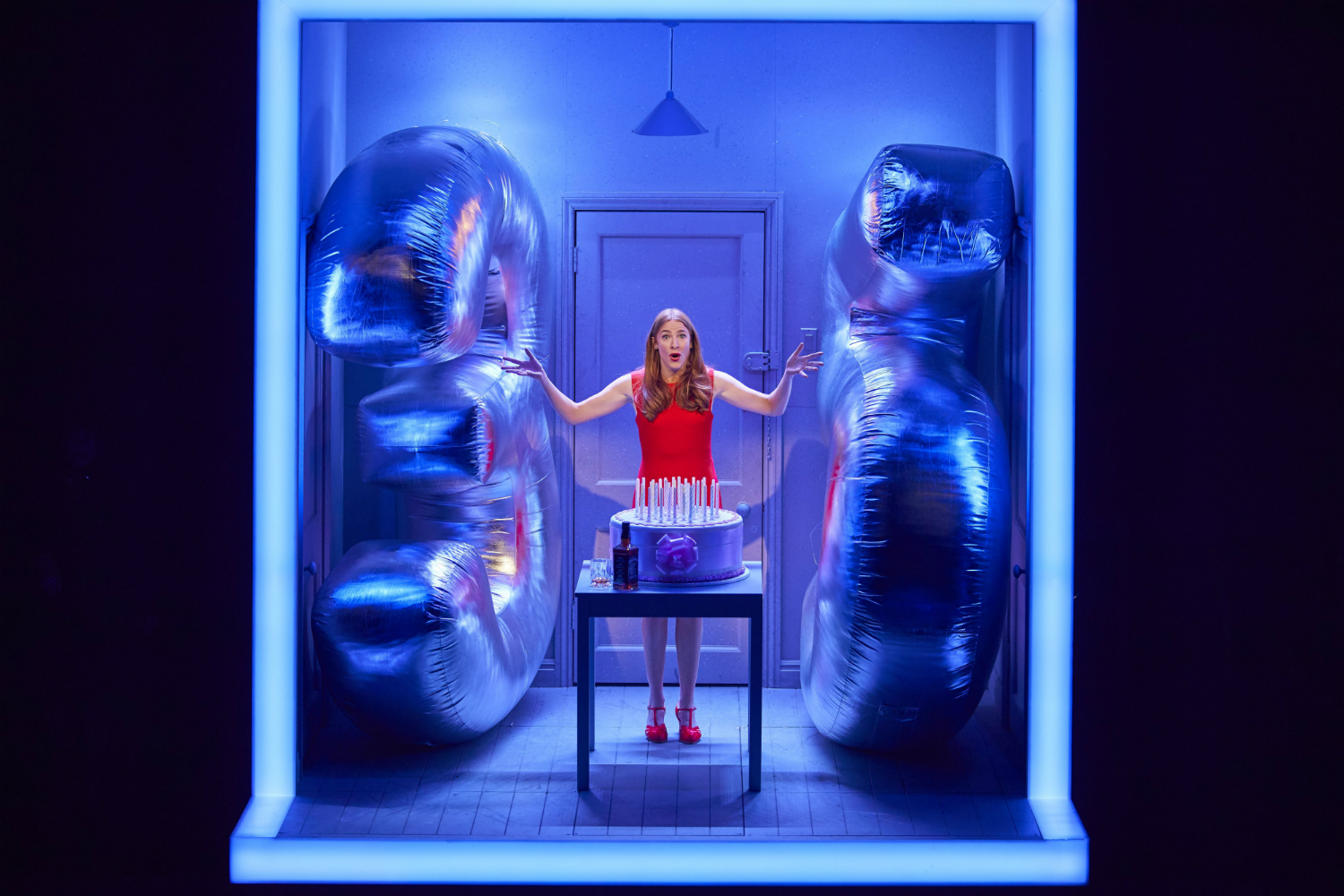When your life is a perplexity – because your friends are needy-bossy, your cute boys aren’t quite right, your choices are urgent but confused – the last thing you need is balloons. Specifically, huge silver balloons bumping along behind you and reminding you how old you are.
Bobbie (Rosalie Craig), heroine of Marianne Elliott’s gloriously rethought version of Sondheim’s Company, hoists herself into her New York apartment on her 35th birthday, a bottle of Jack Daniel’s in her bag and a too-big 35 trailing behind in balloon form. She considers parking the balloon outside, but why announce your first midlife crisis, so she grouchily ushers it in to bob around. Later, she’ll wedge it under the table, where it sulks disconsolate and upside down. Later still, as her long red night of the soul becomes a disorienting dream out of Alice in Wonderland, it’ll swell and separate to squish against the apartment walls or shrink to a miniature. Only towards the very end of the evening will Bobbie exact long-delayed and satisfyingly stabby vengeance.
Why are the balloons hideous? Because hideous they are, however classily their silver foil sheen works with Bunny Christie’s design palette of clean white and ice-blue neon, of red-haired, crimson-frocked Bobbie lost in a swirl of indigo smoke. As Sondheim’s score insistently tick-tocks, as the wheels of Bobbie’s social life spin on the spot, the balloons are an inflated mockery. 35: such an adult age. So why doesn’t Bobbie (a male character in the 1970 original; making her female in this production brings everything into focus) feel like a grown-up? Is this the life she wants to lead? If not – what is that life?
Not talking about work
Where did Bobbie get her balloons? Didn’t buy them herself, obviously. And if there’s a gang of single friends who’d play this kind of jape, we don’t meet them. Must be work then. It’s the kind of things bantersome colleagues would do.
If so, it plays into Company’s weird reticence about the working world. In 1970, the guys seemed white collar, the women stayed home. I imagine Sondheim’s original male Bobby on Madison Avenue, series 7 of Mad Men, during the dog days of the three-martini lunch. Not talking about work because he didn’t talk about much.
But what does modern Bobbie actually do? And why doesn’t she discuss it (beyond muttering about unspecified things she hoped to accomplish)? People talk work and money more than they talk love, especially if they’re in living in a big city where everyone clings on by their fingertips. Sondheim is often good on the compulsion of work – showbiz graft in Follies, baking and barbering in Sweeney Todd – so if Bobbie doesn’t expand on her middle-management, possibly corporate vibe, it suggests that her job is one more thing that doesn’t call on her commitment or deliver satisfaction.
Mid-decade is mid-puzzle
Your 35th. More of a pivot than a rite of passage, unlike the landmark zero-stopped birthdays. Mid-decade is mid-puzzle. You’re not quite the person you were as you stepped into the decade. Or maybe you are, and you’re not sure how to change.
Like anyone acquainted with singlehood, I’ve been a Bobbie. I didn’t climb the corporate ladder or date hot air stewards, but did spend evenings playing third wheel on the tricycle of coupled friends. It’s an odd position – are you there to reflect their contentment, or to bring relief from a less settled world? Are you audience or entertainment? Bobbie does both: shares bourbon and stories from the nights before, then watches as her crazy married friends bicker, break or tie themselves in knots. As she says after each cosy encounter, always with a different aghast intonation: ‘Wow.’
Now I worry that I’ve become part of one of these variously terrible couples. Please god not the pair who are sneakily competitive about diets and cut each other’s stories off at the knees. Or the ones who patronise each other, or who infuriate each other with their jitters and calm. Honestly, there are no attractive couple models in Company.
Patti LuPone’s Joanne, laden with jokes and security, thinks of herself as a role model. She treats this female Bobbie as a trainee, a glitter-hearted snark monster in waiting. It’s an appealing, if fearsome, dynamic. For years, my best friend was a Bobbie – smart and engaged, warmly worldly, partial to a drop of Jack D. And then, somehow, she became Joanne. Suddenly, the jokes were judgements, the smarts were smarting. It hurt to be with her. Perhaps it hurt to be her. That’s the brilliantly sharp trajectory of Elliott’s Company, and it’s why I wrote about LuPone’s scathingly still, terrifyingly personal version of Ladies Who Lunch in my Sunday Times review of the show – ‘what began as gleeful complicity ends in a warning, as if LuPone were urging: it’s too late for me, but save yourself.’
So, yeah, balloons. Hide them, hurl them out the door, stab them with whatever pointy object comes to hand. They’re less a party favour than a portent, and sooner or later you’ll have to deal with them.
Photo by Brinkhoff/Moegenburg
Follow David on Twitter: @mrdavidjays


Leave a Reply